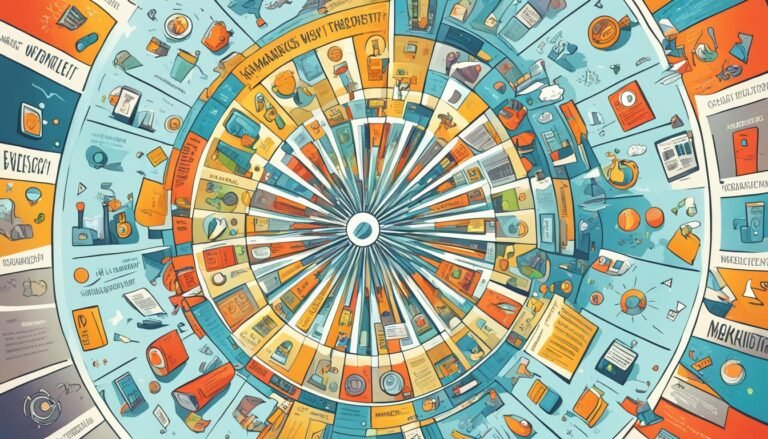Is the AIDA Model Still Relevant?
Did you know the AIDA model has been guiding marketers for over a century? E. St. Elmo Lewis created it in the late 1800s. It helps marketers attract, engage, and convert customers. In today’s digital world, the AIDA model—Attention, Interest, Desire, and Action—is still key for effective marketing.
The AIDA model’s steps are still vital in persuasive communication and sales. But can it keep up with today’s fast, tech-filled market? This article looks into the AIDA model’s lasting value and its fit with modern marketing.
Key Takeaways
- The AIDA model, introduced in the late 1800s by E. St. Elmo Lewis, has been a cornerstone of marketing for over a century.
- The model’s four stages—Attention, Interest, Desire, and Action—outline the customer journey from initial awareness to final purchase.
- Digital channels and evolving consumer behaviors challenge the AIDA model’s linear approach, yet its core principles remain applicable.
- Integrating the AIDA model into modern marketing strategies ensures a structured path for capturing and maintaining consumer interest.
- Exploring the AIDA model’s relevance today helps marketers understand its versatility in adapting to new digital paradigms.
The Origins of the AIDA Model
In 1898, American businessman Elias St. Elmo Lewis changed the game in advertising. He introduced the AIDA model, a step-by-step guide for sales pitches. This approach has grown over the years, becoming key in marketing.
The Birth of AIDA: Elias St. Elmo Lewis
Elias St. Elmo Lewis created the AIDA model in 1898. His aim was to make a clear, effective sales process. This approach changed advertising, offering a roadmap that’s still used today.
It focuses on getting Attention, building Interest, creating Desire, and prompting Action. This method has guided sales for over a century.
Evolution from Sales to Marketing
Originally for sales, AIDA now plays a big role in marketing. With the rise of digital media, it adapted to new ways of reaching people. Now, it’s used in campaigns like J.P. Morgan Chase’s “Mastery” and Goldman Sachs’ “Why I Work Here.”
These campaigns use strong visuals and stories to grab and keep attention. This shows how AIDA has grown from a sales tool to a key marketing strategy.
Breaking Down the AIDA Model
The AIDA model has been key in marketing since 1898, created by Elias St. Elmo Lewis. It shows the steps a customer takes before buying something. These steps are Attention, Interest, Desire, and Action. Let’s look at each part’s role in engaging customers during their buying journey.
Attention: Capturing Initial Interest
Getting a customer’s attention is the first step. With so much content online, it’s hard to stand out. Brands use eye-catching ads, catchy headlines, and unique social media posts to grab attention. Notion uses content marketing to make people aware of its project management tool.
Interest: Maintaining Engagement
After catching attention, keeping it is key. The Interest stage keeps curiosity alive with content that matters to consumers. Using stories or articles that engage helps keep people interested. The New York Times keeps readers hooked with interesting headlines and articles.
Desire: Creating Emotional Connections
The Desire stage aims to make a strong emotional bond with customers. It uses testimonials, case studies, and social proof to make people want the product. Calendly uses these methods to draw people to its scheduling software.
Action: Encouraging the Final Step
The Action stage is about clear call-to-action prompts that push users to act. This could mean buying a product, signing up for a service, or interacting with a brand. Evernote’s website has a simple CTA, “Sign Up for Free,” that guides consumers to the end of their journey.
Modern Marketing Strategies and AIDA
In today’s fast-changing marketing world, it’s key to blend old models like AIDA with new digital tactics. Modern marketers use digital channels, social media, and content marketing to grab attention, spark interest, build desire, and push for action.
Integrating Digital Channels
Using digital channels is crucial to reach lots of people and get them involved. Studies show that 43% of consumers find products on social media, but only 14% buy them there. This shows that digital channels help with awareness and trust, not just sales.
By using many platforms, brands can catch people’s eyes, a key AIDA step. Tools like Google Ads, email, and influencer partnerships help grab potential customers’ attention in the digital world.
Leveraging Social Media
Social media is key in today’s marketing plans. The Edelman Trust Barometer Survey shows trust is key for growth. With 79% of consumers taking part in brand activities, social media is vital for keeping people interested and building a community.
Facebook, Instagram, and LinkedIn are great for keeping people hooked and interacting with them. Videos, live streams, and interactive posts make it fun for brands to keep their audience engaged, fitting the AIDA Interest stage.
Content Marketing and AIDA
Good content marketing is vital for moving people through the AIDA stages. Making content that’s relevant, informative, and engaging helps turn interest into desire. For example, blogs, eBooks, and white papers offer value and spark interest. Customer stories and case studies create an emotional bond, making people want more.
A strong call to action, like a free guide or webinar invite, pushes people to take action, completing the AIDA model. With 67% of people staying loyal to a brand even when things get tough, it shows how important ongoing, quality content is for keeping and deepening customer ties.
Real-World Applications of the AIDA Model
The AIDA model is a strong tool for businesses. It focuses on Attention, Interest, Desire, and Action. Let’s see how big brands use it to grab and keep their audience’s attention.
Attention: Notion’s Content Marketing
Notion stands out by using many content marketing tactics. They use eye-catching visuals, informative blogs, and lively social media. This grabs the interest of potential users right away.
Interest: The New York Times’ Engaging Hooks
The New York Times is great at keeping people interested. They use catchy headlines and deep stories to keep readers hooked. This shows how important it is to keep users involved in marketing.
Desire: Calendly’s Testimonials
Calendly boosts desire by sharing customer success stories. These stories create a strong emotional bond with potential customers. It shows how real people benefit from their scheduling software.
Action: Evernote’s Clear Call-To-Action
Evernote makes it easy to take action with clear calls-to-action on their site. These CTAs help visitors sign up or download easily. Evernote makes the AIDA model work well by making things simple for users.
Challenges in the Digital Age
In today’s fast-paced digital world, the AIDA model from 1898 faces big challenges. Companies like Apple, Netflix, and Adidas use the AIDA model in their marketing. But, they need to change and be flexible because of new market trends.
The digital era has changed how people buy things. Now, there are complex paths to purchase, unlike the old linear stages of Attention, Interest, Desire, and Action. This means online engagement strategies must change often.
Apple used the AIDA model for their iPhone and Apple Watch launches. They focused on making people aware and interested to create a desire for action. Netflix also used the AIDA model in India, creating awareness with strong ads and keeping interest with free trials.
Adidas has also seen success with the AIDA model. They used celebrity endorsements and exclusivity to keep customers engaged. But, these methods might not work for today’s complex consumer interactions. With 79% of consumers engaging with brands on content, social media, and brand initiatives, brands need to adapt their online engagement strategies.
The Edelman Trust Barometer Survey shows 67% of people prefer to stay loyal to a brand, even if it makes mistakes. This shows how important trust is in today’s market. Brands need to communicate clearly and handle mistakes well to build trust.
In conclusion, understanding the digital marketing challenges and consumer behavior is key for marketers today. By using flexible strategies that meet consumer needs, brands can succeed in the digital world while keeping the core of the AIDA model.
Linear vs. Non-Linear Consumer Journeys
In today’s digital world, the difference between linear and non-linear consumer paths is key. The classic AIDA model shows a simple step-by-step process—Awareness, Interest, Desire, Action. But, modern consumers often take a more complex path.
Models like the Customer Decision Journey (CDJ), the Flywheel model, and the Loop Model show how buying patterns have changed. They highlight stages like Discovery, Evaluation, and Post-Purchase Experience. This shows how every touchpoint matters.
The Customer Gravity Model by Anastasia Balova sheds light on non-linear journeys. It shows how keeping customers coming back is key. The journey is ongoing, with constant discovery and evaluation, making ongoing engagement vital for brands.
New funnel models have come up to match these changes. We see looping, hourglass, and micro-moments funnels. These funnels help marketers target different types of users at various stages. They create content that speaks to each phase.
Some, like Mark Ritson, still see value in the classic AIDA model. But most agree we need more flexible strategies. Today’s buyers often go back and forth in their decision-making.
Brands that adapt to these changes can better connect with today’s consumers. This leads to deeper relationships, loyalty, and better results for businesses.
Is the AIDA Model Still Relevant?
The AIDA model relevance has been a topic of discussion among marketers for years. Since its inception in the late 1800s by E. St. Elmo Lewis, and its official acronym debut in 1921 via Printers Ink, the model has stood the test of time. It remains deeply embedded in both traditional and digital marketing strategies.
Over 100 years later, the AIDA model still offers a structured approach to guide consumers through the buying process with marketing effectiveness. The stages of Attention, Interest, Desire, and Action help create targeted and persuasive campaigns. Notably, brands like Apple and Netflix have effectively utilized this model. For instance, Apple created awareness for the iPhone through new product announcements and drew Interest by highlighting its features. Netflix, on the other hand, used outdoor marketing posters of shows like Narcos to generate buzz and offered a free trial to spark curiosity.
- Attention: Adidas collaborates with top athletes and uses exclusive events to grab Attention.
- Interest: The New York Times employs engaging hooks to maintain reader interest and ensure consumer engagement.
- Desire: Calendly leverages testimonials to invoke desire and bridge the gap to the final action.
- Action: Evernote’s clear call-to-action strategy exemplifies how to convert interest into sales.
Despite its effectiveness, the sequential nature of the AIDA model sometimes poses limitations. It assumes a linear journey, which may not always align with a consumer’s path in the digital age. This has led to the development of post-AIDA models such as AIDCAS, which includes Confidence and Satisfaction phases, ensuring post-purchase relationships and fostering long-term trust. Modern consumers often cycle back and forth between stages, making adaptability crucial for marketing effectiveness.
However, the foundational principles still apply: capturing Attention, maintaining Interest, creating Desire, and driving Action. Leading examples like CRED’s 2021 advertisements featuring icons from the 90s, and Adidas’s “see possibilities” campaign highlight the kind of strategies that keep the AIDA model relevant. Understanding this structure ensures that marketing campaigns are effective, leading to higher consumer engagement and successful conversions.
The Role of AI in the AIDA Model
Artificial intelligence makes the AIDA model work better, allowing for marketing that reaches people on a big scale. It uses automation to make content that grabs attention, keeps interest with machine learning, creates desire with predictive analytics, and pushes for action with automated systems.
AI’s Influence on Attention
Artificial intelligence changes how brands get noticed at the start of the AIDA model. With people getting 92 business emails a day, AI helps make subject lines and ads that grab attention. This helps brands get noticed and pull potential customers into the marketing process.
Personalized Interest Through Machine Learning
Machine learning is key in the interest phase of the AIDA model. It looks at lots of data to find out what customers like and what trends are. This lets brands send out content that really speaks to people, keeping them interested in what’s being offered.
Creating Desire with Predictive Analytics
Creating desire is important, turning general interest into a strong emotional bond with a product. Predictive analytics helps marketers know what customers want and need. It sends out messages that really hit home with people. By looking at data and behavior, predictive analytics can see what drives customers to want something more.
Driving Action with Automation
Artificial intelligence and automation make the last part of the AIDA model easier: action. They make buying smooth, from personalized tips to automated follow-ups, making sure customers have a great experience. Automation helps push customers towards buying, finishing the journey from just looking to actually buying.
Artificial intelligence and the AIDA model work together to give marketers a strong tool. This tool uses data and knows a lot about what makes people tick. It makes each part of the customer journey better and keeps marketing up to date with the digital world.
Pros and Cons of the AIDA Model
The AIDA model is still useful today because it guides customers through the buying process clearly. It has both big benefits and some downsides. We’ll look at these points and how being adaptable is key to its ongoing use.
Advantages: Simplicity and Structure
The AIDA advantages include its simple approach. It breaks down the customer journey into clear steps. This makes it easier for marketers and business owners to plan their content and campaigns.
It focuses on key stages like Attention, Interest, Desire, and Action. This helps businesses aim their marketing better, often boosting sales. The AIDA model is easy to grasp, especially for marketing beginners.
It uses tools like TV ads, SEO, and social media to grab attention. Testimonials and pricing strategies help move customers to desire. Finally, clear calls to action and emails encourage customers to buy, showing the model’s effectiveness.
Limitations: Linear Approach
The AIDA model is often criticized for being too linear. It doesn’t match the complex customer paths in today’s marketing. Now, customers interact with brands on many channels and devices, making the sales funnel more complex.
This old-school view can lead to marketing plans that don’t connect with today’s tech-savvy people. As companies use more channels like social media and blogs, the AIDA model’s limits become clear. This shows the need for a more flexible marketing approach.
Adaptability in Modern Marketing
Even with its linear design, the AIDA model is still adaptable. By using digital tools, companies can update the AIDA steps for today’s consumers. Personalized marketing and data analysis help tailor messages to different groups, improving each AIDA stage.
Content marketing is another area where AIDA excels. Good content keeps people interested, solves their problems, and shows brands as experts. Through working with influencers and chatting with customers on social media, companies can make each AIDA stage better.
While the AIDA model has its limits, its main ideas are still very useful. With smart updates and mixes, marketers can use AIDA to handle the digital marketing world’s challenges.
Alternative Marketing Models
Today, people are getting harder to convince with old marketing ways. That’s why new strategies like trust-based marketing and the flywheel approach are getting popular. These methods aim to build strong bonds with customers and make buying easy and smooth.
The Trust-Based Model
The trust-based marketing model is all about building trust with customers. It’s about being honest and clear about what you offer. Brands like Cleo are using this method to connect with Gen Z. They offer personalized financial tools, building trust and transparency with their users.
Trust-based marketing focuses on:
- Transparency: Being open about how things work and what you offer.
- Value Alignment: Making sure your brand’s values match those of your customers.
- Customer-Centric Communication: Talking to customers in a way that builds trust and loyalty.
This approach helps build trust, loyalty, and advocacy. It lets businesses keep customers for the long haul.
The Flywheel Model
The flywheel model is a strategy that keeps the growth cycle going. It’s a circular process that keeps customers coming back and talking about your brand. Companies like Amazon and Google use this method to keep customers engaged at every step.
Key parts of the flywheel approach are:
- Engagement Strategies: Keeping customers interested with content and interaction.
- Sustained Momentum: Getting customers to buy again and support your brand.
- Consumer Empowerment: Letting customers share their experiences to influence others.
This method creates a cycle where happy customers help your business grow. They spread the word and keep interacting, building a strong and loyal customer base.
Trust-based marketing and the flywheel approach are new ways to connect with today’s digital customers. They focus on keeping customers engaged and empowered. This leads to lasting loyalty and success over time.
Conclusion
The AIDA model has been around for over a century. It’s still key to understanding how people act and how to talk to them in marketing today. This summary shows how the model has changed with new tech and digital tools.
Now, 60.99% of people worldwide use social media, with 63% being over 13. This shows how important it is to grab attention and keep people interested with the right content. Brands like Adidas and Coca-Cola use the AIDA model to make messages that really speak to people.
Real examples show how the AIDA model can be used in many ways. Companies like Amazon and Wendy’s use special deals and urgency to move people from just knowing about a product to actually buying it. This shows how important it is to focus on what benefits a product offers.
In the end, the AIDA model may have old-school limits, but it’s still super useful today. By testing different approaches, targeting content well, and using new tech like AI, companies can make their messages more effective. This proves the AIDA model is still key in marketing.
Source Links
- What Is The AIDA Model And Why It Matters | FourWeekMBA
- The AIDA Model in Marketing: Uses & Examples | Impression
- Know Your Marketing Models: AIDA
- What Is the AIDA Model?
- Explaining The AIDA Model for Marketing: Attention, Interest, Desire and Action
- AIDA Model Still Matters In 2023
- The AIDA Model: A Proven Framework for Converting Strangers Into Customers
- The AIDA model and how to apply it in the real world – examples and tips
- Digital Strategies Beyond the AIDA Model for the Modern Consumer – 2Stallions
- Does the AIDA Model Hold Water for Sales in 2024? – Marketing Insider Group
- What is the AIDA Model? + Real Examples That Convert
- How To Use AIDA Model in Digital Marketing
- Is the Traditional Marketing Funnel Still Relevant in Today’s Consumer Landscape?
- The Marketing Funnel: Historical Curiosity or Still Relevant?
- AIDA Model | How Does AIDA Model Work?
- 5 Brands that Successfully Use the AIDA Model –
- Use AI And AIDA Model Marketing To Triple Your Conversions
- Harnessing the Timeless AIDA Marketing Model in the AI-Driven Era
- AIDA Model : Meaning, Working, Benefits, Drawbacks and Examples – GeeksforGeeks
- How AIDA Marketing Works (and How to Make It Work For You)
- The AIDA Model: What Is It & How to Use it?
- Alternatives to AIDA in Use Today
- A Quick Guide to AIDA Content Marketing for B2B SaaS
- What AIDA Means in Marketing
- How AIDA Marketing Model Helps In Growing Your Business | Incrementors







